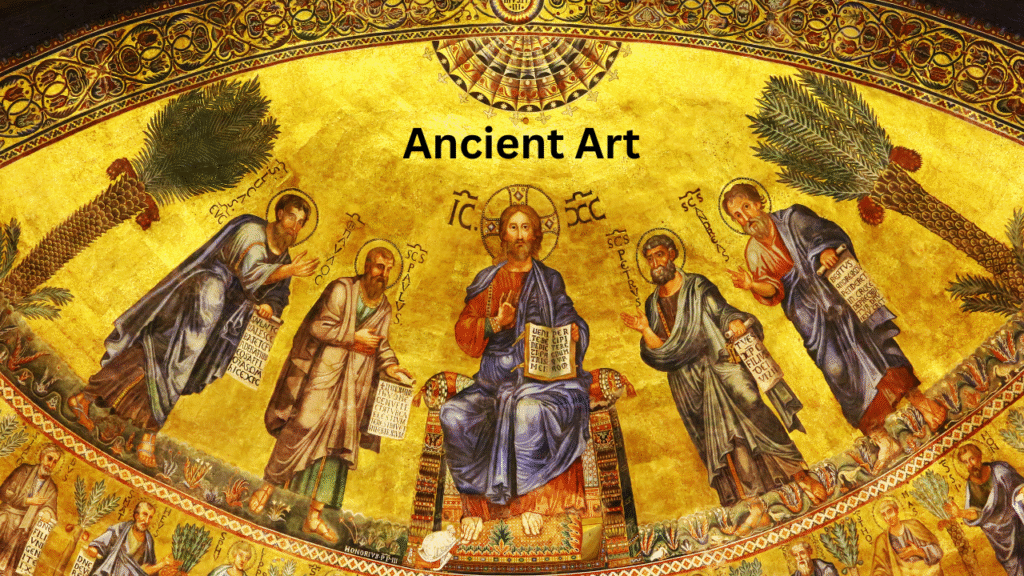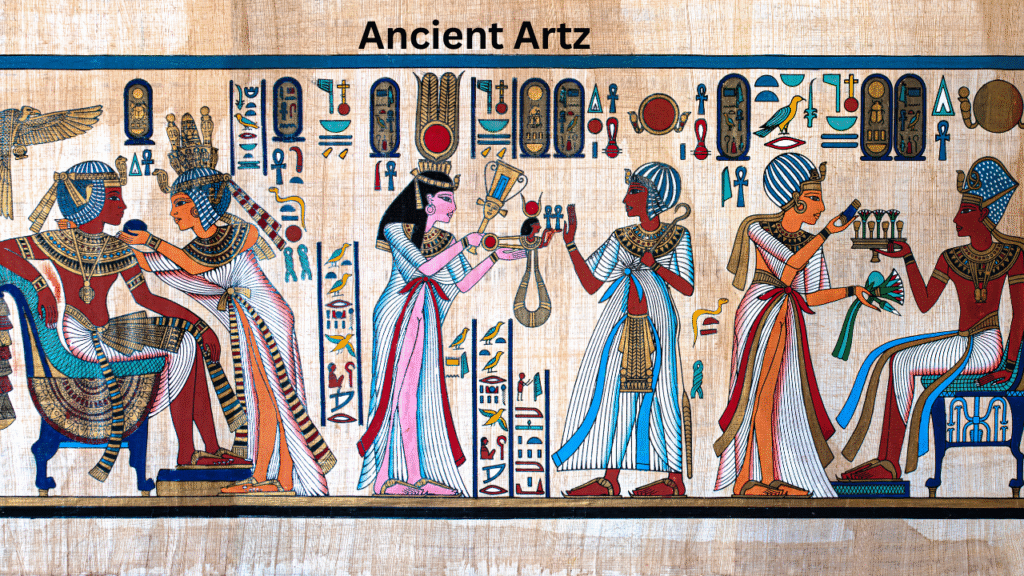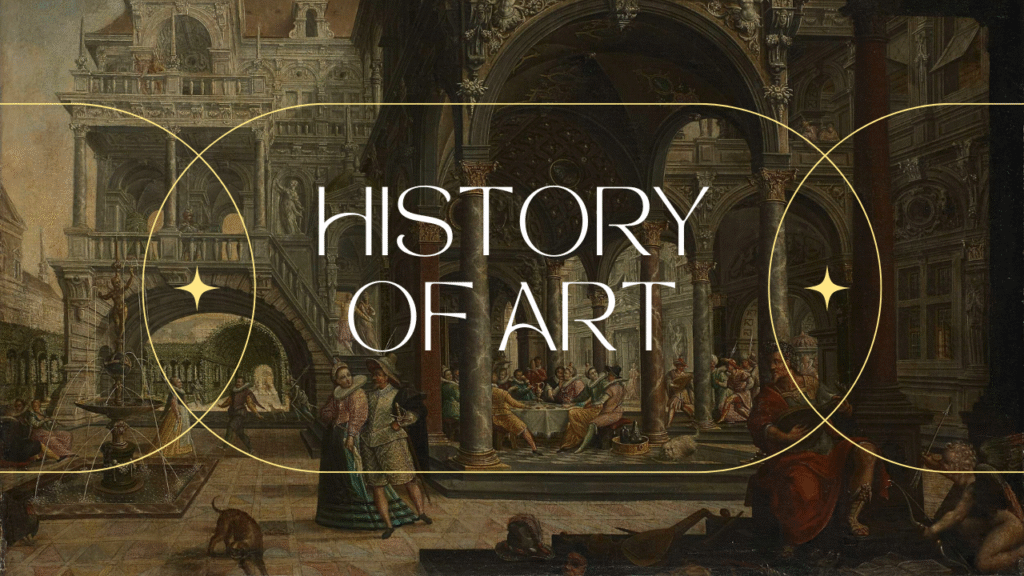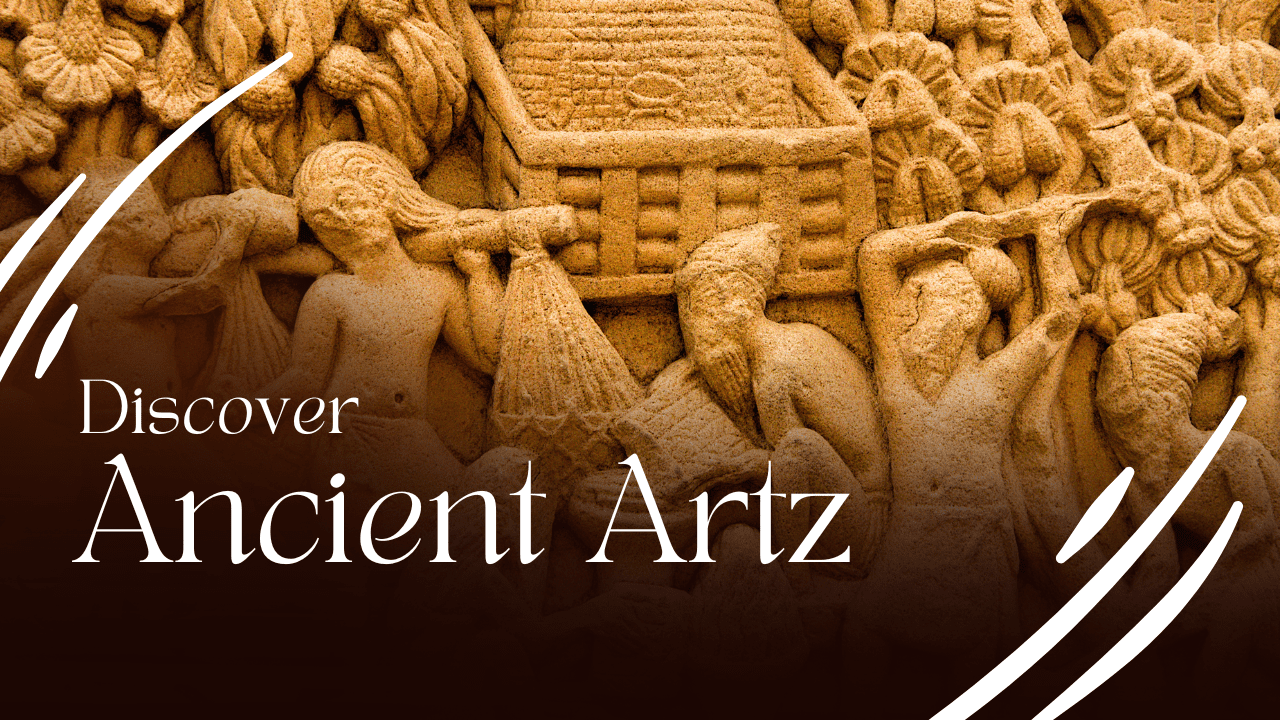Table of Contents
The majority of Ancient Artz that Westerners are familiar with originates from societies that existed during ancient times, or from when they were first invented around 3300 BC and 500 AD. Different forms of art, such as paintings, statues, buildings, cloth, glass, and stone inscriptions, had adorned the historical canvas and therefore, in short, represented different cultures, customs, and social mores of our ancestors. Those artifacts offer the background of the bygone times, the views of the individuals, and details of how land was controlled in ancient days to those who view them.
Ancient Art Timeline
| Period | Date Range | Key Developments |
| Paleolithic | 40,000–14,000 BC | Cave paintings (e.g., Lascaux), Venus figurines |
| Neolithic | 10,000–3,000 BC | Clay idols, Göbekli Tepe pillars |
| Bronze Age | 3,000–1,200 BC | Narmer Palette, Minoan frescoes, Mesopotamian seals |
| Iron Age | 1,200–500 BC | Greek black-figure pottery, Assyrian palace reliefs |
| Classical Antiquity | 500 BC–AD 100 | Greek contrapposto sculptures, Roman portraiture |
| Late Antiquity | AD 100–500 | Christian catacomb frescoes, Byzantine mosaics |
What is Ancient Art?

Definition & Scope of Ancient Art
Ancient artz is the term used for works that were created by humans who had been on the earth for a very long time. The artwork was first produced by people who began learning to write around 3300 BC, and stopped around 500 AD. In this time period, numerous societies thrived and produced many things, which are very impressive.
All those bygone societies gave birth to a lot of art. They made houses, sculptures with perfect details, painted pictures with more colors than, and wrote on stones. All these artworks reflect consummate skills that ancient people had.
Chronological Overview
Art Before Writing (before 3500 BC)
In ancient times, the inside of caves was often used as a canvas for artworks by people producing visual compositions with black paint and red pigment. They tended to draw animals and shapes, which helped them find a way of transferring their thoughts onto a surface and living towards a hope, the ancient thinking and believing. Small figurines of claythato represented women they might have thought were important.
First Big Cities (3500-1200 BC)
Step-like constructions consist of buildings like ziggurats in Mesopotamia. Besides, minor carved artifacts with cylinder-like shapes were made, containing pictures and writing. In Egypt, people were keen on making pictures of their kings. They produced artworks on wallsands some paper-like material while using pyramids to create forms like triangles.
Time of Iron and Old Greece and Rome (1200 BC- 200 AD)
In detail, Greeks created amphora vases with pictures of myths and episodes of life in everyday situations. They even constructed a monumental structure, the Parthenon, indicating their liking for an impossibly perfect environment. Romans designed statues of real humans and covered their floors using mosaic techniques.
End of Ancient Times (200-500 AD)
Then Christianity arrived, and the art took a new turn with the martyrium, an underground graveyard. They combined the old traditional arts paintings with brand new ideas to showcase man’s innovative capacities. However, elsewhere, one group of people took a leaf from Greek art and transformed them making them a unique product of their own.
Ancient art characteristics
Special Meanings in Art
Ancient artwork frequently depicted divinities, kings, and animals that were considered celestially holy. In the case of Egyptian art, people in charge were described as more majestic than the others. This symbolized the one with more power.
Real-looking vs. Simple Shapes
For example, some prehistoric art appeared realistic and lively, such as the bison in the Lascaux caves. However, Egyptian art differs from this. They showed the human figure in the most simplified form, aside from which was always the profile.
What They Used to Make Art
They used the back soot of burnt wood and dirt combined with red oxide. The color in Greek and Roman times for statues was accomplished through the use of gold, ivory, and a wide range of colors by the artists, in contrast to other painting forms.
How They Made Art
Egypt, like the ancient Egyptians, used grids to draw. Greeks, such as the sculptor Polykleitos, made their artistic works realistic by using math to determine how to depict the human form.
Ancient Art Paintings
Ancient paintings span from Paleolithic cave murals to Roman frescoes and Byzantine icons:

Cave Paintings
The Lascaux caves in France have ancient paintings from about 17,000 BC. These depict many animals and scenes of hunting, and they appear to be moving.
Wall Paintings
In old palaces at Knossos, there are paintings on the walls. These display people to be jumping bulls and sea animals.
Wax Paintings
Greek painters utilized beeswax and colorful materials to create eye-catching and long-lasting paintings.
Underground Paintings
Early Christians painted such wall paintings in underground rooms. The paintings tell the stories of the Bible in words and pictures..
Ancient Art Drawings
In the past, artists used drawings to practice their skills and as preliminary sketches for larger works of art. They were usually made as a practice or a detailed sketch to make people better or realize a big art.
Stone Drawings
At that time, Egyptians utilized small pieces of limestone for their art. These pictures depict scenes from daily life, writing practice, and musical performances.
Carrieds
Ancient artists drew their drawings on bones and small stone tablets. These were simple to transport. They visuall tell how they designed a lot of work.
Ancient Art Examples & Descriptions
Venus of Willendorf (28,000 BC)
There is a small stone that is shaped in the form of a woman. It tells us what was the most important thing for our ancestors.
Narmer Palette (3200 BC)
This is a stone plate found in Egypt. It is the picture of the assembly (joining) of the two parts of Egypt. It is an early form of the photograph as the images are told through the photos.
Step Pyramid of Djoser (2650 BC)
Egypt had a huge stone building that was constructed by them. It was built of a number of steps. And this kind of construction was not normal at that time.
Doryphoros (440 BC)
It was a statue of a man from Greece. It looks like his body is perfect. The man was standing differently.
Athena Parthenos (430 BC)
A gold and ivory statue of Αthena was put at the Parthenon. This was a significant accomplishment for the sculpture. The statue was bright and multicolored.
Ancient Artists
Imhotep
Imhotep lived in the Old World aOld Worldt was incredible. He was both a priest and a constructor. History tells us that he made the first large triangle-shaped building called a pyramid.
Phidias
Phidias was an artist with extraordinary talent from ancient Greece. He made stone sculptures for a monumental building, the Parthenon. He also created the enormous statue of Zeus, the almighty god, in Olympia.
Poly, Kleitos
Polykleitos the Great was a metalGreatptor from ancient Greece. He created statues made of a material named bronze. He penned a classic book, “Canon” which he used to teach others including the puzzle of the ideal standard for making the perfect statue.
Regional Traditions
Egypt & Nubia
The big structures include pyramids and temples. In addition, the buildings had colorful wall carvings about the dead, which the priests made.
Mesopotamia & Persia
Carved in clay and stone. Immune to brick walls. Huge tombs that are carved into rocks, which used to serve as the burial places of the kings.
- Clay and stone carvings
- Shiny brick walls
- Big tombs cut into rocks for kings
Aegean & Greece
Wall paintings at Knossos. Stone statues of the good-looking boy were called. Then even statues made in later days were in the totonac nature and human form.
Rome & Byzantium
Face statues that look like real-life buildings with curved roofs. Early versions of Christian art can be found in the windows made of small tiles.
- Life-like face statues
- Buildings with curved roofs
- Early Christian art in small tile pictures
South & East Asia
Smooth stone statues from Maurya. Chinese bronze objects with fanciful designs. Early Buddhist temples in scenic caves.
Mesoamerica & Africa
Big Olmec stone heads. Maya thrones, which were made of stone. Nok clay figures. All these art pieces have a special type of calendar.
Historiography & Scholarship
Art history studies had their beginnings in the European universities of the 1800s. On the other hand, Johann Joachim Winckelmann threw much light on ancient Greek and Roman art. Then it was the turn of scholars to explore art’s meanings and its social roles. A broadened definition of art history looks at art from around the globe and uses different ways to study old art. Dil tools are one of the methods. This gives a clearer picture of the old art in the present culture.

Conclusion
Ancient artz will take us back in history and tell us the history of the people who were associated with. They utilized many material varieties and ways to produce products, which ranged from painting and carving to building and writing. Artists used to refer to the blockchain. Art helps people appreciate each other, so I have something to remember in the long run. In the long run, art expresses the most profound thoughts about people’s lives.


